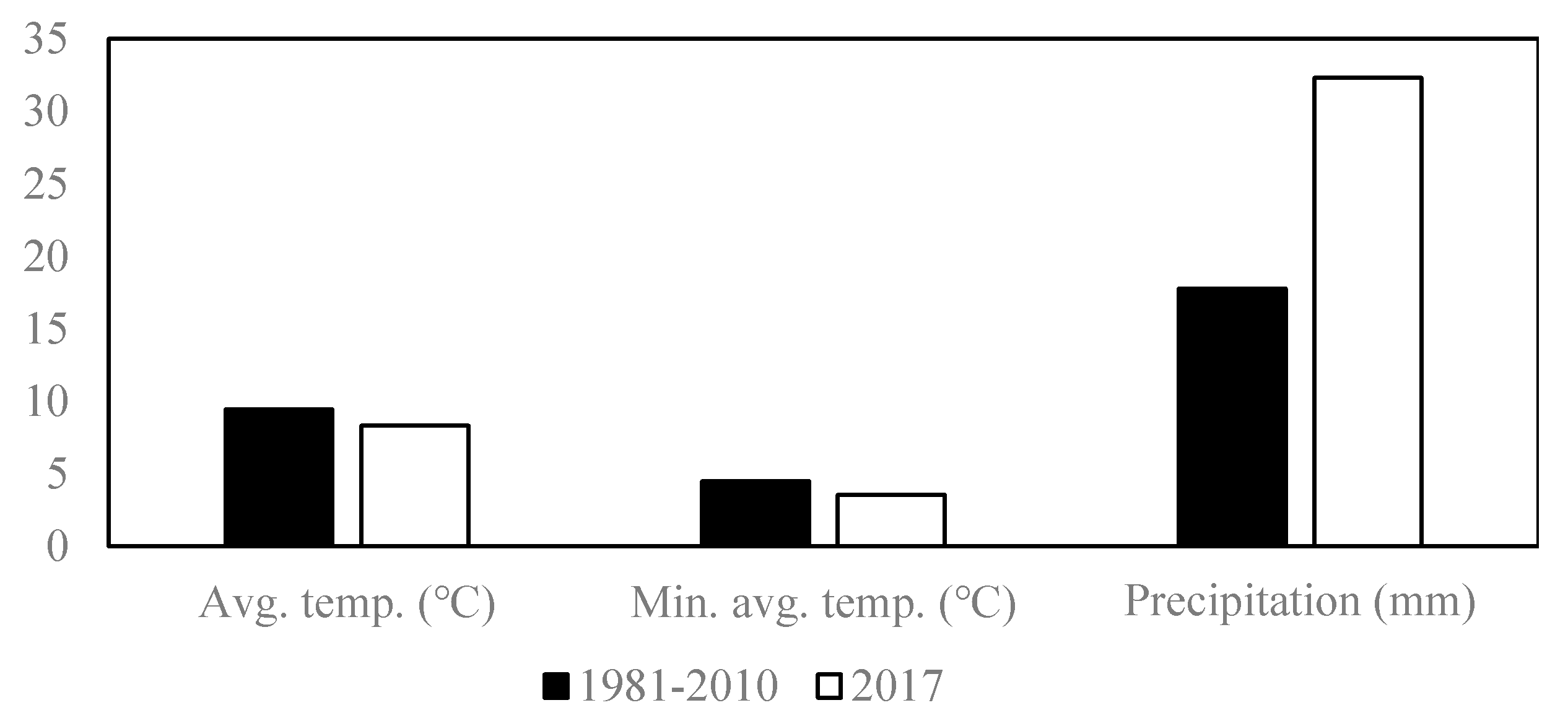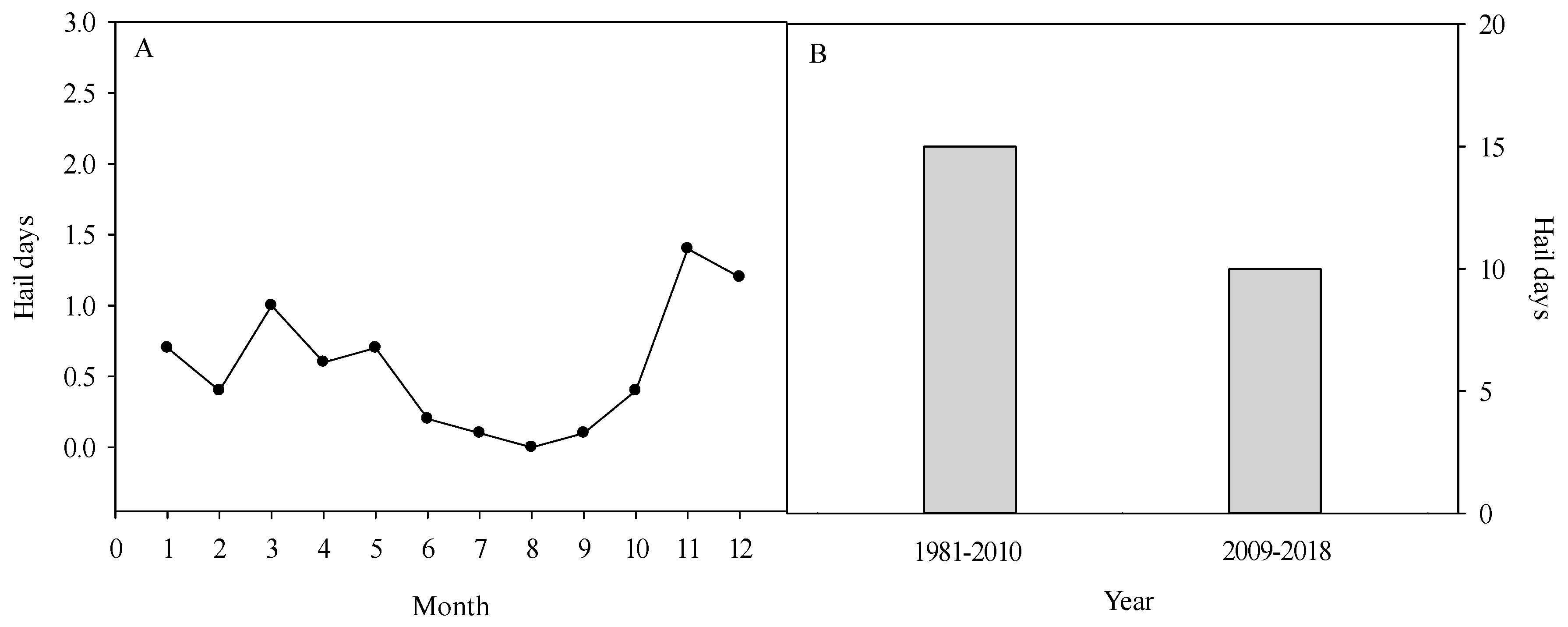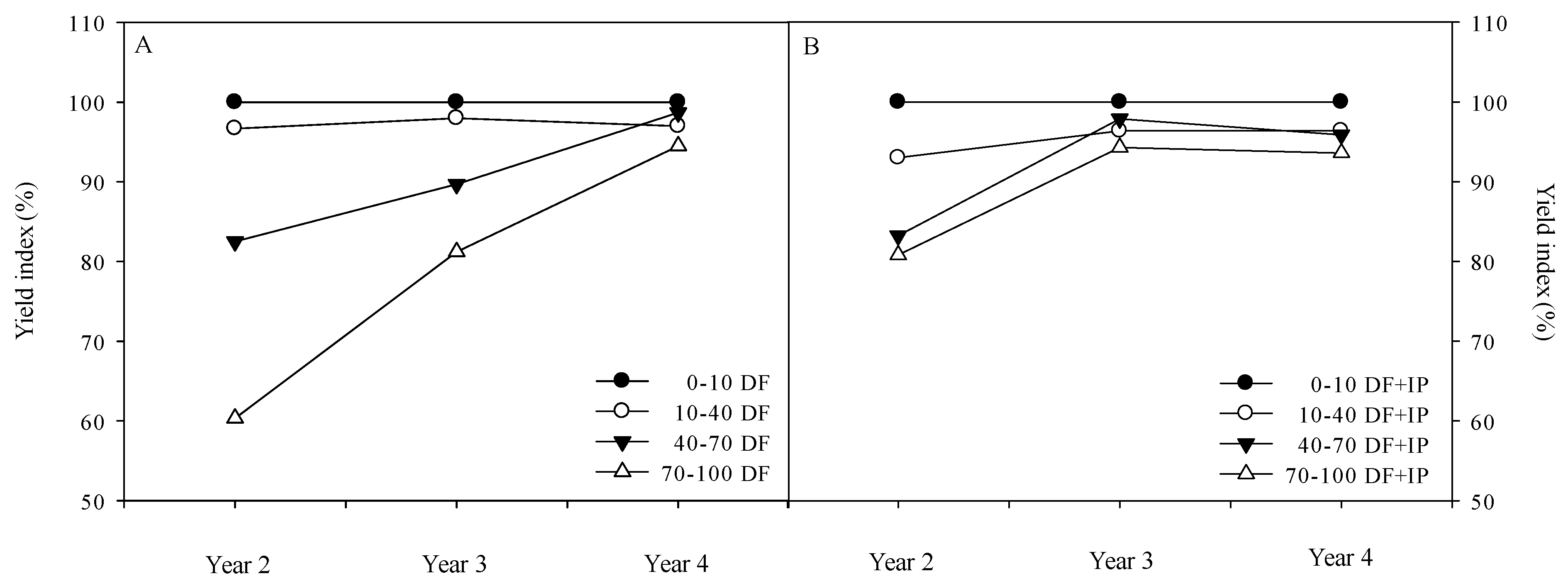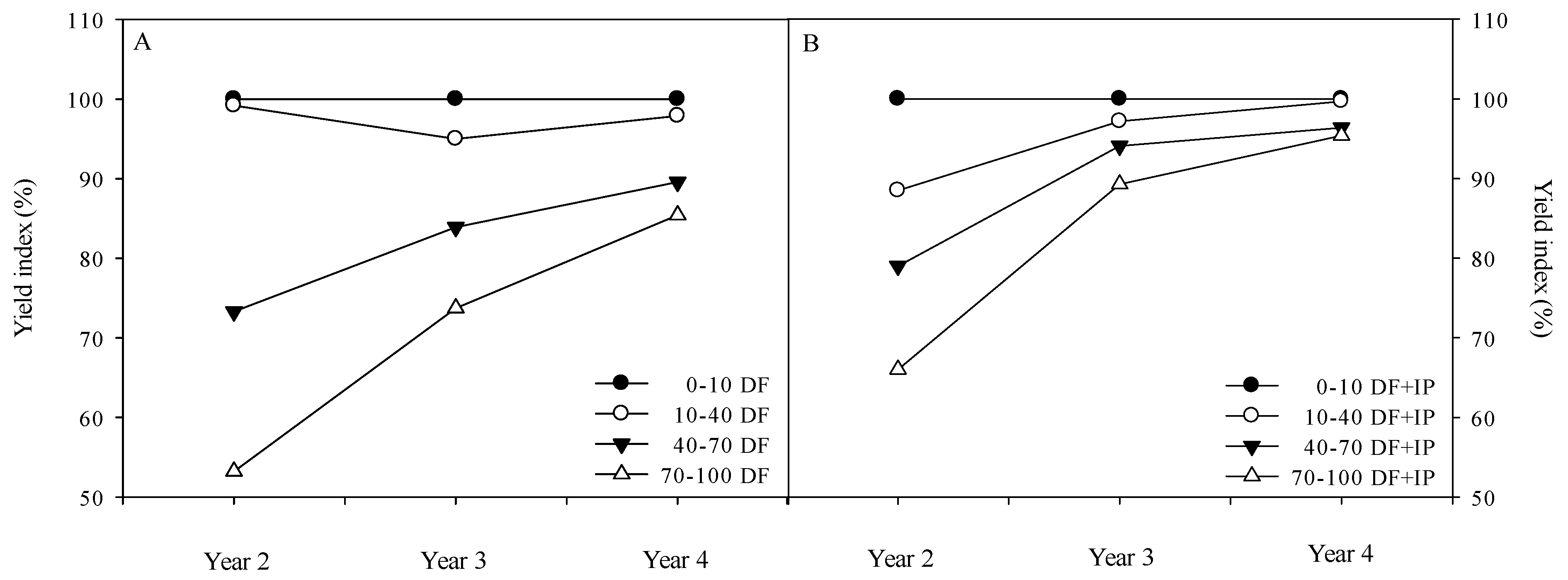Effects of Damaged Levels and Pruning of Peach and Japanese Apricot Trees by Hailstorms on the Performance
Abstract
:1. Introduction
2. Materials and Methods
2.1. Orchard Layout
2.2. Treatment
2.3. Tree Growth and Yield
2.4. Statistical Analysis
3. Results and Discussion
3.1. Hail Damage in Year 1
3.2. Subsequent Tree Damage
4. Conclusions
Author Contributions
Funding
Data Availability Statement
Acknowledgments
Conflicts of Interest
References
- KREI. Agricultural Outlook; Korea Rural Economic Institute: Seoul, Korea, 2019. [Google Scholar]
- Bailly, C. Anticancer properties of Prunus mume extracts (Chinese plum, Japanese apricot). J. Ethnopharmacol. 2020, 246, 112215. [Google Scholar] [CrossRef] [PubMed]
- Lim, Y.J. Special Fruit Science; Hangmungsa Publishing: Seoul, Korea, 2016. [Google Scholar]
- Seo, Y.-H.; Park, Y.-S.; Cho, B.-O.; Kang, A.-S.; Jeong, B.-C.; Jung, Y.-S. Regional distribution of peach freezing damage and chilling days in 2010 in Gangwon province. Korean J. Agric. For. Meteorol. 2010, 12, 225–231. [Google Scholar] [CrossRef]
- Gu, L.; Hanson, P.J.; Post, W.M.; Kaiser, D.P.; Yang, B.; Nemani, R.; Pallardy, S.G.; Meyers, T. The 2007 eastern US spring freeze: Increased cold damage in a warming world? BioScience 2008, 58, 253–262. [Google Scholar] [CrossRef]
- Miranda, C.; Santesteban, L.G.; Royo, J.B. Variability in the relationship between frost temperature and injury level for some cultivated Prunus species. HortScience 2005, 40, 357–361. [Google Scholar] [CrossRef] [Green Version]
- Kim, B.S.; Lee, B.B.; Jung, S.K.; Choi, H.S. Pilot study to evaluate performance of frost-yuzu fruit trees under protected cultivation. Agriculture 2021, 11, 660. [Google Scholar] [CrossRef]
- WMO. Technical Regulations: Basic Documents No. 2; World Meteorological Organization: Geneva, Switzerland, 2018. [Google Scholar]
- Bogo, A.; Casa, R.T.; Agostineto, L.; Gonçalves, M.J.; Rufato, L. Effect of hail protection nets on apple scab in ‘Royal Gala’ and ‘Fuji’ apple cultivars. Crop Prot. 2012, 38, 49–52. [Google Scholar] [CrossRef]
- Biddington, N.L.; Dearman, A.S. The effects of mechanically-induced stress and plant growth regulators on the growth of lettuce, cauliflower and bean (Phaseolus vulgaris L.) plants. Plant Growth Regul. 1987, 5, 183–194. [Google Scholar] [CrossRef]
- Tartachnyk, I.; Blanke, M.M. Effect of mechanically-simulated hail on photosynthesis, dark respiration and transpiration of apple leaves. Environ. Exp. Bot. 2002, 48, 169–175. [Google Scholar] [CrossRef]
- Bosco, L.C.; Bergamaschi, H.; Cardoso, L.S.; de Paula, V.A.; Marodin, G.A.B.; Brauner, P.C. Microclimate alterations caused by agricultural hail net coverage and effects on apple tree yield in subtropical climate of Southern Brazil. Bragantia 2018, 77, 181–192. [Google Scholar] [CrossRef] [Green Version]
- Kim, J.S.; Yoon, J.T.; Cho, D.H.; Choi, B.S.; Lee, W.S.; Oh, J.Y. Survey of the hailstorm damages on apple trees in Kyungbuk area in 1992. Korean J. Hortic. Sci. Technol. 1994, 35, 345–350. [Google Scholar]
- Neely, D. Healing of wounds on trees. J. Am. Soc. Hortic. Sci. 1970, 95, 536–540. [Google Scholar]
- Krasniqi, A.-L.; Blanke, M.; Kunz, A.; Damerow, L.; Lakso, A.; Meland, M. Alternate bearing in fruit tree crops: Past, present and future. Acta Hortic. 2017, 1177, 241–248. [Google Scholar] [CrossRef]
- Minas, I.S.; Tanou, G.; Molassiotis, A. Environmental and orchard bases of peach fruit quality. Sci. Hortic. 2018, 235, 307–322. [Google Scholar] [CrossRef]
- KMA. Statistical Analysis of Climate; Korea Meteorological Administration: Seoul, Korea, 2019.
- RDA. Criteria of Fertilizer Application in Crops; Rural Development Administration; Sammi Press: Wanju, Korea, 2011. [Google Scholar]
- Lim, J.H.; Kim, E.S.; Lee, B.R.; Kim, S.H.; Jang, K.C. An analysis of the hail damages to Korean forests in 2017 by meteorology, species and topography. Korean J. Agric. For. Meteorol. 2017, 19, 280–292. [Google Scholar]
- Punge, H.J.; Kunz, M. Hail observations and hailstorm characteristics in Europe: A review. Atmos. Res. 2016, 176, 159–184. [Google Scholar] [CrossRef]
- Vitasse, Y.; Schneider, L.; Rixen, C.; Christen, D.; Rebetez, M. Increase in the risk of exposure of forest and fruit trees to spring frosts at higher elevations in Switzerland over the last four decades. Agric. For. Meteorol. 2018, 248, 60–69. [Google Scholar] [CrossRef]
- Bussi, C.; Genard, M. Thinning and pruning to overcome alternate bearing in peach trees. Eur. J. Hortic. Sci. 2014, 79, 313–317. [Google Scholar]
- Dobbs, R.C.; McMinn, R.G. Hail damage to a new white spruce and lodgepole pine plantation in central British Columbia. For. Chron. 1973, 49, 174–175. [Google Scholar] [CrossRef] [Green Version]
- Sound, S.A. The influence of severity and time of foliar damage on yield and fruit quality in apple (Malus domestica Borkh.). Eur. J. Hortic. Sci. 2021, 86, 270–279. [Google Scholar]
- Demirtas, M.N.; Bolat, I.; Ercisli, S.; Ikinci, A.; Olmez, H.A.; Sahin, M.; Altindag, M.; Celik, B. The effects of different pruning treatments on the growth, fruit quality and yield of ‘Hacihaliloglu’ apricot. Acta Sci. Pol. Hortorum Cultus 2010, 9, 183–192. [Google Scholar]
- Grossman, Y.L.; DeJong, T.M. Training and pruning system effects on vegetative growth potential, light interception, and cropping efficiency in peach trees. J. Am. Soc. Hortic. Sci. 1998, 123, 1058–1064. [Google Scholar] [CrossRef] [Green Version]
- Kumar, M.; Rawat, V.; Rawat, J.; Tomar, Y. Effect of pruning intensity on peach yield and fruit quality. Sci. Hortic. 2010, 125, 218–221. [Google Scholar] [CrossRef]
- Charrier, G.; Ngao, J.; Saudreau, M.; Améglio, T. Effects of environmental factors and management practices on microclimate, winter physiology, and frost resistance in trees. Front. Plant Sci. 2015, 6, 259. [Google Scholar] [CrossRef] [PubMed] [Green Version]
- Kreuzwieser, J.; Gessler, A. Global climate change and tree nutrition: Influence of water availability. Tree Physiol. 2010, 30, 1221–1234. [Google Scholar] [CrossRef] [PubMed]
- Smith, M.W.; Rohla, C.T. Pecan orchard damage and recovery from ice storms. HortTechnology 2009, 19, 83–90. [Google Scholar] [CrossRef] [Green Version]




| Damage Levels (%) | Shoot Damage (%) | Shoot Length (cm) | Scaffold Damage (%) | Fruit Yield (ton/ha) | Marketable Fruit (%) |
|---|---|---|---|---|---|
| Peach | |||||
| 0–10 | 0.0 d | 56.4 b | 0.0 d | 25.3 a (100) | 88.4 a |
| 10–40 | 56.6 c | 45.6 c | 7.8 c | 4.5 b (18) | 10.6 a |
| 40–70 | 75.8 b | 55.2 b | 8.3 b | 1.3 c (5) | 4.9 c |
| 70–100 | 100.0 a | 63.8 a | 100.0 a | 0.0 d (0) | 0.0 d |
| Japanese apricot | |||||
| 0–10 | 0.0 d | 45.8 b | 0.0 d | 21.5 a (100) | 90.6 a |
| 10–40 | 86.8 c | 32.5 d | 82.3 c | 3.2 b (15) | 16.9 b |
| 40–70 | 95.3 b | 44.6 c | 90.2 b | 1.2 c (6) | 6.5 c |
| 70–100 | 100.0 a | 50.4 a | 100.0 a | 0.6 d (3) | 2.5 d |
| Treatment | Number | Avg. Length (cm) | Avg. Base Diameter (cm) | ||||||
|---|---|---|---|---|---|---|---|---|---|
| Year 2 | Year 3 | Year 4 | Year 2 | Year 3 | Year 4 | Year 2 | Year 3 | Year 4 | |
| 0–10 DF | 353 c | 336 c | 325 c | 63 a | 61 a | 62 a | 7.7 a | 7.5 a | 7.4 ab |
| 0–10 DF + IP | 425 a | 407 a | 346 a | 53 d | 56 b | 62 a | 6.9 b | 7.2 b | 7.6 a |
| 10–40 DF | 336 d | 330 c | 331 bc | 62 a | 56 b | 62 a | 7.5 a | 7.1 b | 7.3 abc |
| 10–40 DF + IP | 377 b | 395 a | 343 ab | 56 c | 53 c | 62 a | 6.5 c | 6.8 c | 7.4 ab |
| 40–70 DF | 325 ef | 325 cd | 325 c | 59 b | 53 c | 63 a | 6.9 b | 6.8 c | 7.1 cd |
| 40–70 DF + IP | 360 c | 365 b | 340 ab | 55 c | 57 b | 56 b | 5.6 e | 6.6 cd | 7.2 bcd |
| 70–100 DF | 316 ef | 316 d | 324 c | 57 c | 52 c | 61 a | 6.6 c | 6.2 e | 7.1 cd |
| 70–100 DF + IP | 310 f | 332 c | 332 bc | 63 a | 56 b | 54 c | 5.8 d | 6.4 de | 7.0 d |
| p value | |||||||||
| Level | <0.001 | ns | ns | <0.001 | ns | ns | <0.01 | <0.001 | <0.001 |
| Method | <0.05 | <0.001 | <0.001 | <0.05 | ns | <0.01 | <0.001 | ns | ns |
| Treatment | Shoot Per Tree | ||||||||
|---|---|---|---|---|---|---|---|---|---|
| Number | Avg. Length (cm) | Avg. Base Diameter (cm) | |||||||
| Year 2 | Year 3 | Year 4 | Year 2 | Year 3 | Year 4 | Year 2 | Year 3 | Year 4 | |
| 0–10 DF | 320 c | 343 bcd | 316 cd | 69 a | 72 a | 71 a | 6.7 a | 6.6 a | 6.8 a |
| 0–10 DF + IP | 362 a | 375 a | 351 a | 44 f | 50 e | 69 ab | 5.8 d | 5.2 e | 6.6 a |
| 10–40 DF | 311 cd | 336 cde | 311 cd | 65 b | 66 b | 67 ab | 6.6 a | 6.5 a | 6.6 a |
| 10–40 DF + IP | 336 b | 353 b | 348 a | 46 e | 49 ef | 63 abc | 5.6 e | 5.5 de | 6.7 a |
| 40–70 DF | 305 cd | 325 de | 308 d | 64 b | 60 c | 66 ab | 6.4 b | 6.2 b | 6.3 ab |
| 40–70 DF + IP | 320 c | 344 bc | 345 a | 48 e | 47 f | 62 bc | 5.2 f | 5.3 e | 6.3 ab |
| 70–100 DF | 301 cd | 321 ef | 309 d | 60 c | 53 d | 64 abc | 6.1 c | 5.7 cd | 5.9 c |
| 70–100 DF + IP | 270 d | 310 f | 336 b | 52 d | 51 e | 57 c | 5.9 c | 5.9 c | 6.0 bc |
| p value | |||||||||
| Level | <0.001 | <0.001 | <0.05 | ns | ns | <0.05 | ns | ns | <0.001 |
| Method | <0.05 | <0.05 | <0.001 | <0.001 | <0.001 | ns | <0.001 | <0.001 | ns |
| Treatment | Tree Canopy (m2) | Number of Fruiting | ||||
|---|---|---|---|---|---|---|
| Year 2 | Year 3 | Year 4 | Year 2 | Year 3 | Year 4 | |
| 0–10 DF | 21.2 cd | 22.3 d | 22.5 a | 288 a | 265 a | 236 a |
| 0–10 DF + IP | 24.6 a | 25.4 a | 22.6 a | 288 a | 265 a | 215 c |
| 10–40 DF | 21.0 d | 22.0 e | 22.2 a | 288 a | 262 a | 228 b |
| 10–40 DF + IP | 23.8 b | 24.2 b | 22.4 a | 276 b | 250 bc | 212 c |
| 40–70 DF | 19.4 e | 21.5de | 21.8 ab | 250 d | 245 c | 235 a |
| 40–70 DF + IP | 22.5 c | 23.2 c | 22.3 a | 263 c | 256 ab | 209 cd |
| 70–100 DF | 18.2 f | 20.6 e | 21.5 b | 180 e | 220 d | 227 b |
| 70–100 DF + IP | 20.6 de | 22.6 cd | 21.8 ab | 258 c | 262 a | 205 d |
| p value | ||||||
| Level | <0.01 | <0.05 | <0.05 | <0.001 | <0.05 | ns |
| Method | <0.001 | <0.001 | ns | ns | ns | <0.001 |
| Treatment | Tree Canopy (m2) | Number of Fruiting | ||||
|---|---|---|---|---|---|---|
| Year 2 | Year 3 | Year 4 | Year 2 | Year 3 | Year 4 | |
| 0–10 DF | 18.6 a | 19.1 a | 20.4 a | 1650 ab | 1580 bc | 1650 a |
| 0–10 DF + IP | 18.2 a | 18.5 b | 19.2 b | 1760 a | 1650 a | 1602 b |
| 10–40 DF | 18.2 a | 18.8 ab | 20.1 a | 1620 b | 1550 c | 1640 a |
| 10–40 DF + IP | 17.0 b | 16.6 d | 19.1 b | 1660 ab | 1620 ab | 1580 c |
| 40–70 DF | 15.8 c | 17.7 c | 18.4 bc | 1260 e | 1380 d | 1550 d |
| 40–70 DF + IP | 16.5 b | 16.4 d | 18.0 c | 1500 c | 1610 b | 1560 d |
| 70–100 DF | 12.6 d | 16.5 d | 17.6 cd | 1030 f | 1230 e | 1510 e |
| 70–100 DF + IP | 12.8 d | 15.2 e | 17.1 d | 1320 d | 1580 bc | 1520 e |
| p value | ||||||
| Level | <0.001 | <0.001 | <0.001 | <0.001 | <0.05 | <0.001 |
| Method | ns | <0.05 | ns | ns | <0.001 | ns |
Publisher’s Note: MDPI stays neutral with regard to jurisdictional claims in published maps and institutional affiliations. |
© 2021 by the authors. Licensee MDPI, Basel, Switzerland. This article is an open access article distributed under the terms and conditions of the Creative Commons Attribution (CC BY) license (https://creativecommons.org/licenses/by/4.0/).
Share and Cite
Kim, B.-S.; Cho, H.-S.; Cho, K.-C.; Kim, H.-J.; Lee, B.-B.; Gu, M.; Choi, H.-S. Effects of Damaged Levels and Pruning of Peach and Japanese Apricot Trees by Hailstorms on the Performance. Agronomy 2021, 11, 2178. https://doi.org/10.3390/agronomy11112178
Kim B-S, Cho H-S, Cho K-C, Kim H-J, Lee B-B, Gu M, Choi H-S. Effects of Damaged Levels and Pruning of Peach and Japanese Apricot Trees by Hailstorms on the Performance. Agronomy. 2021; 11(11):2178. https://doi.org/10.3390/agronomy11112178
Chicago/Turabian StyleKim, Byeong-Sam, Hye-Sung Cho, Kyung-Chul Cho, Hyo-Jung Kim, Bo-Bae Lee, Mengmeng Gu, and Hyun-Sug Choi. 2021. "Effects of Damaged Levels and Pruning of Peach and Japanese Apricot Trees by Hailstorms on the Performance" Agronomy 11, no. 11: 2178. https://doi.org/10.3390/agronomy11112178
APA StyleKim, B.-S., Cho, H.-S., Cho, K.-C., Kim, H.-J., Lee, B.-B., Gu, M., & Choi, H.-S. (2021). Effects of Damaged Levels and Pruning of Peach and Japanese Apricot Trees by Hailstorms on the Performance. Agronomy, 11(11), 2178. https://doi.org/10.3390/agronomy11112178





